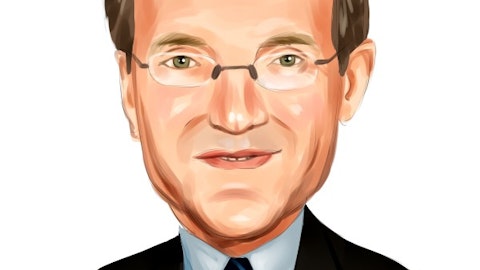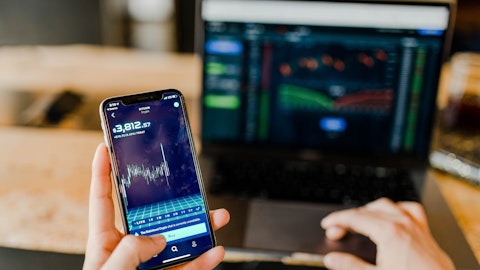Unidentified Analyst: Hi, good afternoon. Thanks for taking my question. I just had a follow-up on the provisions. I’m just wondering why a portion of it was reclassified. I just wanted to understand a little bit better the reason for that.
Pedro Freitas: Hi, Alejandra, I will answer in Portuguese. The question is why was there a reclassification in the Alagoas system for accounts payable. Well, Alejandra that is an accounting rule. So, it’s an obligation that essentially is represented by the flow of payments. So, someone does some work, some contracts are signed. And at that point, you have an obligation to make a payment. And that number every quarter has been in the order of BRL100 million or BRL200 million. But we’ve also signed an agreement with the municipal government, and they still have some amount that is due. But since as an obligation that has a specific payment schedule predefined that is included. So, it’s an accounting issue that you’ll see in our presentation that we are providing that information, those numbers. So, it is a net predetermined agreement with municipal government, BRL1.7 billion. We’ve already paid BRL700 million, so BRL1 billion is remaining.
Unidentified Company Representative: So, we have some questions related to institutional aspects. So, I’m going to put the questions together. Major part has already been answered. There is an interest. There’s a person interested in the topics of China. They ask if we are going to be a net exporter of PE in the long term. And then I’m going to ask the other questions.
Rosana Avolio: [indiscernible] asked this question. So, I would like to thank for the question. In relation to China, I’m going to make some general comments, and then I’ll go into specifics about polyethylene. China has been in searching for self-efficiency in different sectors. This was no different in our petrochemical sector. So, in 2015, when we see the convergence of the products that we have with our company. China had some targets of sales efficiency for polypropylene and polypropylene — and since then, first, we had polypropylene and then the other. And naturally, China has several feedstocks and has been adding capacity since then. And more recently, China has a line of polyethylene also. So, I’m going to divide into CPMP [ph].
As for PP, we believe that China is going to reach self-sufficiency. The consulting firms inform us that is sometimes is difficult to follow all the data provided by China. And China has already reached 91% of self-sufficiency in polypropylene. But as for propylene, the nature of the business is a little more regional. Still commodities, but it’s more regional when compared to polyethylene. And this happens because between the difference between more and less producers from the view point of cost is lower. So, what do I mean by this? Braskem is a leader in polypropylene in the Americas. And when we are more focused on the regional level, of course, we have protections. We are large, nature protection even. And when we talk about polyethylene and when we see the data provided by consulting firms, we imagine that China is only reached polyethylene’s efficiency close to 2030, 2032.
So, there’s still a long journey ahead of us, about 10 years ahead of us. And when we look at the same comparison of PPE and PP and when we see the producer, which is more or less competitive in the global curve of cost, it’s more or less relevant. The polyethylene market is more global. So, it’s important that in the polyethylene, we should have industry and Braskem should have access to competitive feedstock. And when we look at the journey that we’ve gone through. First, when we consolidated the Brazilian market, when we started our process of going international, we have been in this search, searching for feedstock diversification and competitive raw materials. Now talking specifically about polyethylene. Braskem has Mexico. Mexico is one of the main producer, more competitive producer.
We have some diversification in Brazil, but we still have a base in Brazil that ensures this competitiveness when we compare with the industry at large. Let me make another consideration about China. When we talk about our self-sufficiency of polyethylene and polypropylene in the long term. I’m not considering any type of restriction, any government restriction related to reduction of carbon. And this is something that is being discussed by companies. I’m not even considering this in the curve. And this can change the scenario of new capacities. It may even be an entry barrier when we consider new capacities for the future.
Unidentified Company Representative: I’m going to move on with the questions Pedro. Okay go ahead. Could you inform what was the cash burn and how much was added to the provision for Alagoas in relation to what was planned for 2023 with an additional provision for the fourth quarter.
Pedro Freitas: Well, there was an additional provision in Q4. That was in the order of BRL1 billion. And in Q4, our disbursements that were made — they were in the order of BRL400 million, a little bit more than that. So that was the effect of Q4. Now for the year, I don’t have those numbers. Rosana, do you have them?
Rosana Avolio: Yes, for the year, we spent in 2023, BRL2.7 billion in the consolidated year.
Unidentified Company Representative: My last question since we have already answered many of the questions. The question is, is the provision to backfill the original 9 mines was BRL3.8 billion. Why the additional provision to backfill 6 more mines? Is only about BRL500 million.



